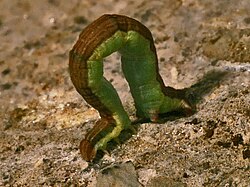| Lythria cruentaria | |
|---|---|
 | |
| Scientific classification | |
| Domain: | Eukaryota |
| Kingdom: | Animalia |
| Phylum: | Arthropoda |
| Class: | Insecta |
| Order: | Lepidoptera |
| Family: | Geometridae |
| Genus: | Lythria |
| Species: | L. cruentaria |
| Binomial name | |
| Lythria cruentaria (Hufnagel, 1767) | |
| Synonyms | |
| |
Lythria cruentaria is a moth of the family Geometridae. The species can be found in Europe.
The length of the forewings is 9–13 mm. The moths fly in two or three generations from the end of April to the end of September. .

The caterpillars feed on sorrel and sheep's sorrel.